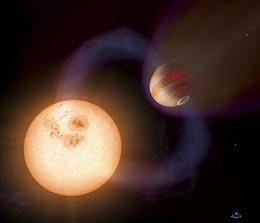Gassy signature of habitability spied in the atmosphere of a 'hot Jupiter'.
Carbon dioxide, one of the telltale signs that a planet may be able to support life, has been spotted in the atmosphere of a gas giant orbiting a star 63 light years from Earth.
Although there's no way that this particular planet could support life, being able to spot carbon dioxide in its atmosphere offers hope for probing the atmospheres of planets more like Earth — and so bolstering the search for life outside the Solar System.
 Carbon dioxide has been discovered in the atmosphere of HD 189733b — a 'hot Jupiter' exoplanet like the one in this artist's impression.NASA, ESA and A. Schaller
Carbon dioxide has been discovered in the atmosphere of HD 189733b — a 'hot Jupiter' exoplanet like the one in this artist's impression.NASA, ESA and A. SchallerHD 189733b is a hot Jupiter — a planet similar in mass to Jupiter in our Solar System, but one that orbits much closer to its star, and so is much hotter. Giovanna Tinetti from University College London, UK and her colleagues have managed to measure the spectrum of the light coming from the day side of the planet using a technique called 'secondary transit'.
This involves recording the light spectrum of the planet and its star, and then measuring the spectrum of the star alone while the planet is hidden behind it. The difference of the two spectra is the spectrum of the light coming directly from the planet. Tinetti used the Near Infrared Camera and Multi-Object Spectrometer (NICMOS) onboard the Hubble Space Telescope.
What emerged was a spectrum that, after its absorption and emission part were disentangled and it was compared with theoretical models, revealed the presence of carbon dioxide in the planet's atmosphere.
"This is an exciting result," says Tinetti. "This is the first near-infrared spectrum of a planet. Even from a technical point of view it's a nice result."
Spectacular finding
"Carbon dioxide is one of the big four biomarkers for a habitable, if not inhabited planet," says Alan Boss from the Department of Terrestrial Magnetism at the Carnegie Institution of Washington, who was not involved with the work. The other three are water, methane and oxygen – and now oxygen is the only one left to be observed in the atmosphere of a planet outside the Solar System. "They really have nailed it," Boss says of the result.
The NICMOS instrument looks at the near-infrared part of the spectrum whereas previous studies of this planet using the Spitzer Space Telescope have been looking at different areas of the spectrum where a carbon dioxide signature wouldn't show up, such as the mid-infrared region. These different instruments also probe different layers of the atmosphere so that ultimately a picture of the chemistry going on between them can be gleaned.
"It's a spectacular data set," says Sara Seager from the Massachusetts Institute of Technology, Cambridge. "It's astonishing that we can detect molecules in exoplanet atmospheres." The detection of carbon dioxide is particularly surprising, Seager says, because other forms of carbon, such as carbon monoxide or methane, would be expected to dominate in the hot, hydrogen-rich atmosphere. Tinetti and her colleagues put this down to an unusually high carbon-to-oxygen ratio in this planet's atmosphere.
Boss is impressed that even with the low resolution of this spectrum, the carbon dioxide signal is so clear. "It's amazing what you can do with a telescope like Hubble that was never designed to do planetary observations like this," he says.
Softly softly
Tinetti and her team are being cautious about inferring too much from their results, but they hope that with more observations they will be able to work out the origin of this carbon dioxide, and whether it comes from a photochemical or thermochemical reaction. They have managed to roughly calculate the abundance of carbon dioxide in this atmosphere as being about 0.00001 times the amount of the most abundant gas, molecular hydrogen. The results were presented at a meeting about molecules in extrasolar planetary atmospheres held in Paris from 19-21 November, and will be published in the Astrophysical Journal.
"This planet we keep observing is nowhere near habitable," says Tinetti, "but all these measurements give us an opportunity to train ourselves." And with that training, astronomers will be able to go and find, and characterize, planets that are just like our own. "We're extremely close to the moment when we find a one-Earth-mass planet," Tinetti says.



No comments:
Post a Comment